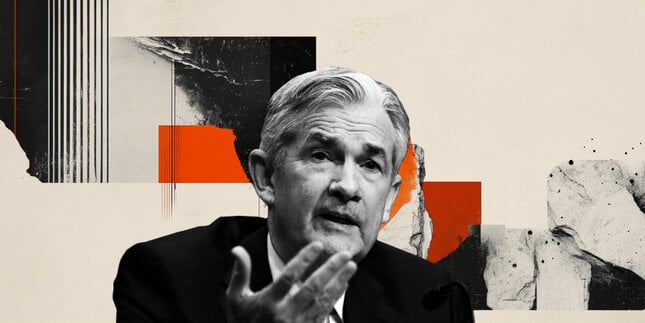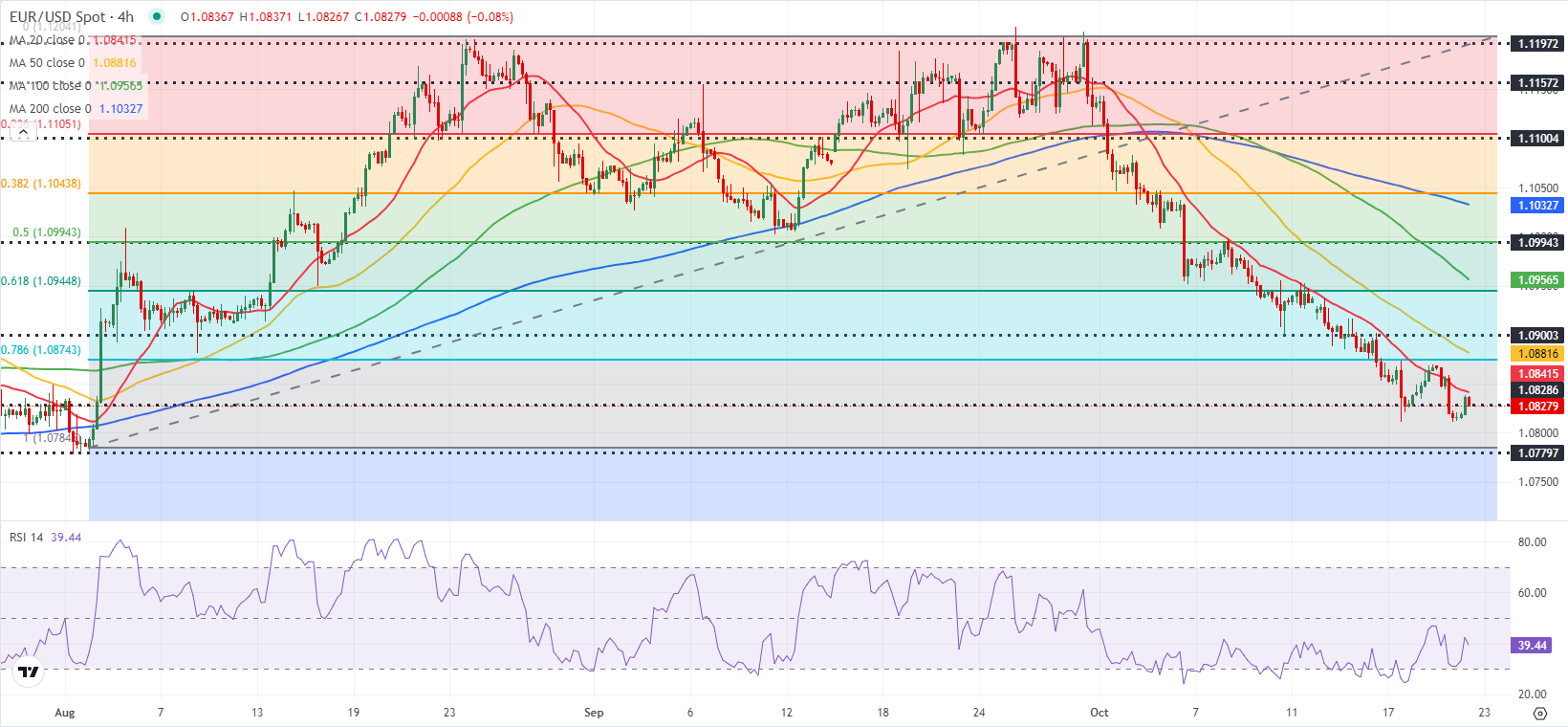- EUR/USD clings to modest daily gains above 1.0800 on Tuesday.
- ECB President Lagarde will be speaking later in the day.
- The near-term technical outlook remains bearish despite the latest recovery attempt.
EUR/USD came under bearish pressure in the second half of the day on Monday and closed in negative territory. The pair clings to modest recovery gains above 1.0800 early Tuesday as investors await comments from European Central Bank (ECB) President Christine Lagarde.
Euro PRICE Last 7 days
The table below shows the percentage change of Euro (EUR) against listed major currencies last 7 days. Euro was the weakest against the US Dollar.
| USD | EUR | GBP | JPY | CAD | AUD | NZD | CHF | |
|---|---|---|---|---|---|---|---|---|
| USD | 0.74% | 0.52% | 0.82% | 0.26% | 0.68% | 0.70% | 0.28% | |
| EUR | -0.74% | -0.22% | 0.08% | -0.50% | -0.04% | -0.05% | -0.45% | |
| GBP | -0.52% | 0.22% | 0.29% | -0.26% | 0.18% | 0.17% | -0.17% | |
| JPY | -0.82% | -0.08% | -0.29% | -0.55% | -0.13% | -0.12% | -0.49% | |
| CAD | -0.26% | 0.50% | 0.26% | 0.55% | 0.42% | 0.45% | 0.07% | |
| AUD | -0.68% | 0.04% | -0.18% | 0.13% | -0.42% | 0.01% | -0.34% | |
| NZD | -0.70% | 0.05% | -0.17% | 0.12% | -0.45% | -0.01% | -0.36% | |
| CHF | -0.28% | 0.45% | 0.17% | 0.49% | -0.07% | 0.34% | 0.36% |
The heat map shows percentage changes of major currencies against each other. The base currency is picked from the left column, while the quote currency is picked from the top row. For example, if you pick the Euro from the left column and move along the horizontal line to the US Dollar, the percentage change displayed in the box will represent EUR (base)/USD (quote).
In the absence of high-tier data releases, the risk-averse market environment helped the US Dollar (USD) preserve its strength on Monday, forcing EUR/USD to stay on the back foot.
ECB President Lagarde will participate in a conversation with Bloomberg journalist Francine Lacqua at 14:30 GMT. Comments from ECB policymakers showed on Monday that they keep an open-mind about lowering the policy rate again in December, amid growing signs of an economic downturn in the Euro area. In case Lagarde adopts a dovish tone by voicing her optimism about continuous progress in disinflation, the Euro could have a difficult time staying resilient against its major rivals.
Later in the day, Lagarde will be appearing in a panel discussion about the future of cross-border payments during the 2024 Annual Meetings of the International Monetary Fund (IMF) and the World Bank Group (WBG) in Washington DC. She is unlikely to comment about the policy outlook during this event.
The Relative Strength Index (RSI) indicator stays below 50 after recovering from near-30 it touched on Monday, suggesting that the bearish bias remains intact following a technical correction.
Looking south, 1.0800 (static level, round level) could be seen as interim support before 1.0780 (beginning point of the latest uptrend) and 1.0740 (static level from April).
On the upside, immediate resistance could be spotted at 1.0870 (Fibonacci 78.6% retracement of the latest uptrend) ahead of 1.0900 (static level, round level). A daily close above the latter could discourage sellers and open the door for another leg higher toward 1.0950 (Fibonacci 61.8% retracement).
Euro FAQs
The Euro is the currency for the 19 European Union countries that belong to the Eurozone. It is the second most heavily traded currency in the world behind the US Dollar. In 2022, it accounted for 31% of all foreign exchange transactions, with an average daily turnover of over $2.2 trillion a day. EUR/USD is the most heavily traded currency pair in the world, accounting for an estimated 30% off all transactions, followed by EUR/JPY (4%), EUR/GBP (3%) and EUR/AUD (2%).
The European Central Bank (ECB) in Frankfurt, Germany, is the reserve bank for the Eurozone. The ECB sets interest rates and manages monetary policy. The ECB’s primary mandate is to maintain price stability, which means either controlling inflation or stimulating growth. Its primary tool is the raising or lowering of interest rates. Relatively high interest rates – or the expectation of higher rates – will usually benefit the Euro and vice versa. The ECB Governing Council makes monetary policy decisions at meetings held eight times a year. Decisions are made by heads of the Eurozone national banks and six permanent members, including the President of the ECB, Christine Lagarde.
Eurozone inflation data, measured by the Harmonized Index of Consumer Prices (HICP), is an important econometric for the Euro. If inflation rises more than expected, especially if above the ECB’s 2% target, it obliges the ECB to raise interest rates to bring it back under control. Relatively high interest rates compared to its counterparts will usually benefit the Euro, as it makes the region more attractive as a place for global investors to park their money.
Data releases gauge the health of the economy and can impact on the Euro. Indicators such as GDP, Manufacturing and Services PMIs, employment, and consumer sentiment surveys can all influence the direction of the single currency. A strong economy is good for the Euro. Not only does it attract more foreign investment but it may encourage the ECB to put up interest rates, which will directly strengthen the Euro. Otherwise, if economic data is weak, the Euro is likely to fall. Economic data for the four largest economies in the euro area (Germany, France, Italy and Spain) are especially significant, as they account for 75% of the Eurozone’s economy.
Another significant data release for the Euro is the Trade Balance. This indicator measures the difference between what a country earns from its exports and what it spends on imports over a given period. If a country produces highly sought after exports then its currency will gain in value purely from the extra demand created from foreign buyers seeking to purchase these goods. Therefore, a positive net Trade Balance strengthens a currency and vice versa for a negative balance.
Information on these pages contains forward-looking statements that involve risks and uncertainties. Markets and instruments profiled on this page are for informational purposes only and should not in any way come across as a recommendation to buy or sell in these assets. You should do your own thorough research before making any investment decisions. FXStreet does not in any way guarantee that this information is free from mistakes, errors, or material misstatements. It also does not guarantee that this information is of a timely nature. Investing in Open Markets involves a great deal of risk, including the loss of all or a portion of your investment, as well as emotional distress. All risks, losses and costs associated with investing, including total loss of principal, are your responsibility. The views and opinions expressed in this article are those of the authors and do not necessarily reflect the official policy or position of FXStreet nor its advertisers. The author will not be held responsible for information that is found at the end of links posted on this page.
If not otherwise explicitly mentioned in the body of the article, at the time of writing, the author has no position in any stock mentioned in this article and no business relationship with any company mentioned. The author has not received compensation for writing this article, other than from FXStreet.
FXStreet and the author do not provide personalized recommendations. The author makes no representations as to the accuracy, completeness, or suitability of this information. FXStreet and the author will not be liable for any errors, omissions or any losses, injuries or damages arising from this information and its display or use. Errors and omissions excepted.
The author and FXStreet are not registered investment advisors and nothing in this article is intended to be investment advice.
Recommended Content
Editors’ Picks

EUR/USD turns negative below 1.0900, Dollar regains traction
EUR/USD now comes under fresh downside pressure following an acceptable pick-up in the Greenback, slipping back to the area below 1.0900 the figure in response to disheartening headlines from China regarding US tariffs

GBP/USD trims losses and recedes to 1.2750
GBP/USD is now giving away part of the initial move to the boundaries of the 1.2800 region, retreating towards the 1.2750 zone amid decent gains and despite a modest recovery attempt in the US Dollar.

Gold rebounds toward $3,020 as trade war tensions remain high
Gold gathers bullish momentum and climbs toward $3,020 after suffering heavy losses on Monday. Improving market mood and rising US Treasury bond yields cap XAU/USD's upside, while a lack of headlines hinting at easing trade tensions supports the pair.

Who is Satoshi? Crypto lawyer sues DHS to reveal Satoshi Nakamoto's identity
James Murphy, a cryptocurrency lawyer popularly known to his followers on X as "MetalLawMan," has filed a lawsuit in a D.C. District Court against the Department of Homeland Security (DHS). He intends to uncover the real face or faces behind Satoshi Nakamoto, the pseudonymous creator of Bitcoin.

The Fed is looking at a hefty price level
We are still in thrall to tariffs, the faux-macro “data” driving markets. The WSJ editorial board advised other countries to take their tariffs to zero so that Trump’s “reciprocal” tariffs will have to be zero, too. Cute, but no cigar.

The Best brokers to trade EUR/USD
SPONSORED Discover the top brokers for trading EUR/USD in 2025. Our list features brokers with competitive spreads, fast execution, and powerful platforms. Whether you're a beginner or an expert, find the right partner to navigate the dynamic Forex market.
